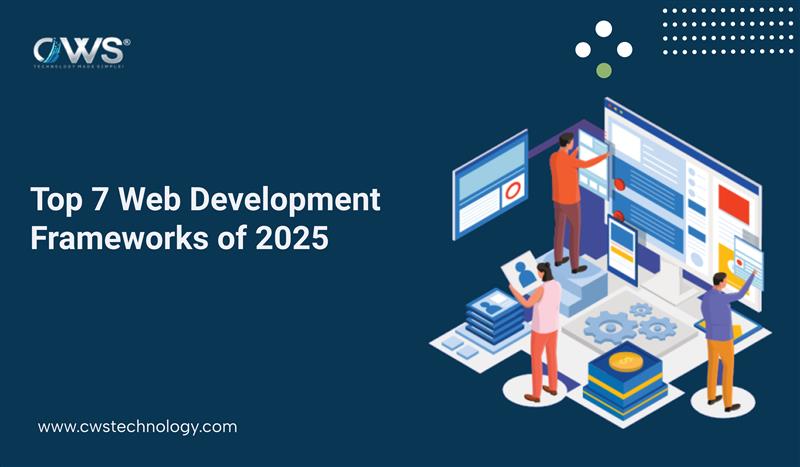Web development has evolved over the years with simple websites at the beginning of the 21st century to sophisticated ones in 2025. There are many web development frameworks which are being used currently.
Web development frameworks are software packages or libraries that are used by developers to build, test, and deploy websites or web applications. They help in saving time and effort by providing code for common tasks.
In this blog, we will discuss in detail the top 7 web development frameworks for 2025.
7 Best Web Development Frameworks
Let’s have a look at the 7 top web development frameworks in 2025. You should choose your ideal framework based on your requirements.
- React
React, which was developed by Facebook, is considered by developers to be one of the best web development frameworks. It has a component-based architecture and is like a library.
Major advantages of React include bringing HTML into JavaScript, which helps in writing code quickly. It can also segregate complex UI into smaller components and develop them.
It has many handy tools that can be used as Chrome extensions. This allows developers to debug the DOM quickly.
- Angular
It was first introduced by Google in 2010 as AngularJS, which introduced two-way data binding and dependency injection. It was rewritten again in 2016 and released as Angular 2.
The current version of Angular offers solid performance, especially for large enterprise systems. Its built-in features are robust, but the complexity and size of Angular can cause performance overhead.
The Angular community is active, and support from Google will ensure that there will be regular updates.
Angular’s ecosystem includes official tooling and libraries, and it is extensively used in corporate environments.
- Ruby on Rails
Ruby on Rails is a server-side web application framework, which is written in Ruby. It helps the web application programmer by providing what is needed to start the web development work.
Ruby on Rails speeds up the development process as it has a convention over configuration approach. The framework emphasizes on making use of standard conventions to decrease the code required to be written by developers.
Ruby on Rails also has a collection of plugins and gems that can add more features to web applications.
- Laravel
Laravel is an open-source web development framework that is PHP-based. It is well-known for ease of use and being powerful at the same time. Laravel has a collection of packages and tools that can be used by developers to add more functionality.
Laravel also has a templating engine called Blade, that helps in creating templates. It has a flexible routing system to define URLs for your application.
It has an ORM or Object Relational Mapping tool called Eloquent, which is very helpful in database operations.
- Svelte
Svelte is a different type of framework that shifts most of the work to compile time. This means that Svelte compiles application code to optimise vanilla JavaScript, which results in fast-running code.
Svelte’s approach leads to fast runtime performance and small size bundles. It is ideal for small, fast loading applications.
Although Svelte’s community is relatively smaller than React, Angular, and Vue, it has been growing. This community is working hard to expand its tools and third-party libraries.
It is also easy to learn, especially for those who know modern JavaScript. Svelte does not have a virtual DOM, and the syntax is very simple.
- Flask
Flask has become a popular choice for developers who want to go for efficient web development. Due to its flexibility, Flask enables the speedy development of projects ranging from small-scale to medium-sized ones.
Flask is unique because of its minimalistic approach, although it can also be used to create complex applications.
It comes with only essential tools and libraries needed for web application development. Flask has a very good community support with extensive documentation and third-party libraries.
Flask does not interfere with architectural decisions and leaves them to the developer. It has
a “batteries included” approach, which allows developers to use a wide range of
functionalities via extensions.
- Qwik
Qwik is an innovative web development framework that is specifically meant to eliminate the issue of slow loading of pages. This is done by downloading and executing the minimum amount of code which is required to load the page.
Qwik’s performance is based on its resumable architecture for instant loading. Additional code is loaded only when required. This makes Qwik an ideal choice for slower networks and devices.
Although Qwik’s community is still growing, its unique features have attracted developers.
It is not very difficult to learn, due to its “resumable” approach to development. Qwik’s concepts are powerful but it can take time to learn how to use them to your advantage.
Qwik’s ecosystem is still growing, but it is designed in accordance with the tools and libraries already present. If its ecosystem continues to grow, Qwik has good future-proofing potential.
Best Practices for Using Web Development Frameworks
Let’s have a look at some of the best practices you must follow when using web development frameworks. These are needed to ensure successful project outcomes.
- Follow Coding Standards
You should follow the guidelines and coding standards prescribed by the framework. This ensures code readability and maintainability.
- Understand the Framework
Its core concepts and features should be clearly understood to make use of its full potential. You should dedicate time to learn the ins and outs of the framework you will be using.
- Handle Errors With Grace
You should implement error handling mechanisms to gracefully handle unexpected situations and provide informative error messages. Make use of tools like error boundaries to identify errors.
- Version Control
Make use of version control systems to track changes, and coordinate with team members. For efficient development workflows, follow the branching strategies.
- Documentation
You should document your code, configurations and project structure to facilitate adding new
team members, collaboration and future maintenance.
Wrapping Up…
We have discussed the top 7 web development frameworks which are being used in 2025. All of them have their own unique features and functionalities. You should carefully consider your requirements and accordingly choose your framework.
For your web development requirements and other IT services, you can get in touch with CWS Technology.








